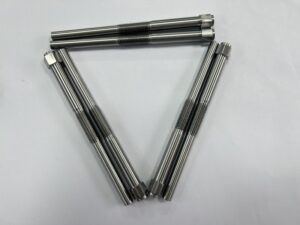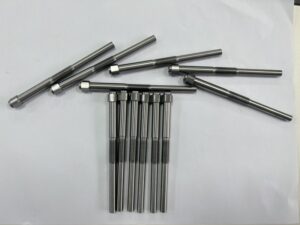类别
- 消息 (43)
轴类零件是五金配件中经常遇到的典型零件之一. 它们主要用于支撑传动部件, 传递扭矩和承受载荷. 根据轴类零件的不同结构形式, 一般可分为光轴, 阶梯轴和异型轴. 轴分为三种; 或分成实心轴, hollow shafts, ETC.


The center type CNC lathe (center machine/slitting lathe) is a kind of CNC machine tool mainly used in the precision machining of shafts and non-standard shafts. It has a qualitative leap in processing efficiency and processing accuracy compared with CNC lathes. Because Two-axis arrangement of tools greatly reduces the processing cycle time. By shortening the tool exchange time between the tool arrangement and the opposite tool table, the overlapping function of multiple tool tables, the overlapping function of the effective axis movement of thread chips, and the direct spindle during secondary processing The indexing function realizes the shortening of idling time. The cutting tool is always processed at the clamping part of the spindle and the workpiece, which ensures that the processing accuracy remains unchanged. The maximum processing diameter of the centering machine on the market is 42mm, which has great advantages in the precision shaft processing market. This series of machine tools can be equipped with an automatic feeding device to realize fully automated production of a single machine tool, reducing labor costs and product defect rates. It is very suitable for mass production of precision shaft parts.
In industrial products, shaft parts are suitable for one or more CNC machined part maintenance operations. They are used in machines to support transmission parts such as gears and pulleys to transmit torque or motion. Shaft parts are rotating parts whose length is greater than the diameter, and generally consist of the outer cylindrical surface, conical surface, inner hole, thread and corresponding end surface of the concentric shaft.
A shaft with an aspect ratio of less than 5 is called a short shaft, and one with an aspect ratio greater than 20 is called a slender shaft, and most shafts are in between.
The shaft is supported by bearings, and the shaft section that fits with the bearing is called the journal. The journal is the assembly benchmark of the shaft, and their accuracy and surface quality are generally required to be high. The technical requirements are generally formulated according to the main function and working conditions of the shaft, and usually include the following items:
(a) Surface roughness
Generally, the surface roughness of the shaft diameter matched with the transmission part is Ra2.5~0.63μm, and the surface roughness of the supporting shaft diameter matched with the bearing is Ra0.63~0.16μm.
(b) Mutual position accuracy
The position accuracy requirements of shaft parts are mainly determined by the position and function of the shaft in the machine. Generally, the coaxiality requirements of the shaft journal for assembling the transmission part to the supporting shaft journal should be guaranteed, otherwise the transmission accuracy of the transmission part (gear, ETC。) will be affected and noise will be generated. For ordinary precision shafts, the radial runout of the matching shaft section to the supporting journal is generally 0.01~0.03mm, and for high-precision shafts (such as spindles), it is usually 0.001~0.005mm.
(c) Geometry accuracy
The geometric shape accuracy of shaft parts mainly refers to the roundness and cylindricity of the journal, outer tapered surface, Morse taper hole, ETC。, and its tolerance should generally be limited within the dimensional tolerance range. For the inner and outer circular surfaces with high precision requirements, the allowable deviation should be marked on the drawing.
(d) Dimensional accuracy
In order to determine the position of the shaft, the supporting journal usually requires high dimensional accuracy (IT5~IT7). The dimensional accuracy of the journal of the assembled transmission parts is generally lower (IT6~IT9).